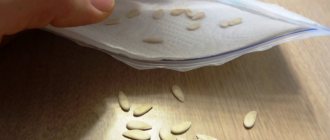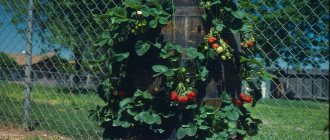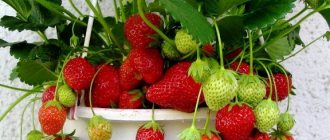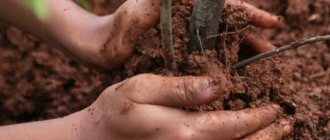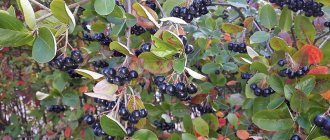Year-round cultivation of strawberries in a greenhouse pays off only with high yields, and they require decent areas. A horizontal structure made of PVC pipes will allow you to reduce the area allocated for strawberries without losing efficiency.
Growing strawberries (garden strawberries) in pipes is suitable not only for those who do it for profit, but also for ordinary summer residents. After all, a structure made of pipes takes up almost no space and is easily transported, which means it becomes an additional bed without taking away precious meters, of which there are already few in a standard dacha.
The essence of technology
Growing strawberries using this method is carried out mainly in PVC pipes intended for laying sewers. They are installed in a vertical or horizontal position, giving the structures the desired shape.
The general essence of the technique is as follows:
- a pipe with a cross-section of at least 16 cm (most often plastic, but aluminum or steel can also be used) is prepared in a suitable way - either holes with a diameter of 8–10 cm are made in it with an interval of 22–25 cm, or it is cut lengthwise into 2 equal parts;
- in the first option, holes for plants are placed depending on the method of installation of the system: for horizontal - only on one side, for vertical - in any order;
- the second option is only suitable for horizontal installation;
- in both cases, a thin tube with drilled small holes is laid inside the main pipe to supply water for the purpose of organizing watering and fertilizing;
- then drainage and soil mixture are added and strawberries are planted.
When using hydroponics, the system is arranged differently:
- a nutrient solution is used instead of soil;
- Expanded clay is poured into plastic cups and strawberry bushes are planted;
- cups are placed inside;
- Water circulation is carried out using an aquarium pump, due to which the nutrient solution is supplied to each plant and then pumped into a special container.
Any two-meter pipe filled with soil mixture or hydroponics can accommodate as many bushes as can be planted in an area of 24 square meters. m. But hydroponics is used extremely rarely in households, since it requires special equipment. Therefore, only the option with soil should be considered.
Related article:
How to feed strawberries in the fall
In addition to saving space, planting strawberries in tubes has several other significant benefits, including:
- the possibility of growing not only in the garden, but also in a variety of other places with suitable environmental conditions - on the terrace, loggia, balcony, greenhouse, gazebo, along the fence, etc.;
- mobility of the structure, which, if necessary, can be moved to another point at any time;
- obtaining clean, beautiful berries that do not come into contact with the soil;
- no need for tillage (the soil does not need to be weeded and loosened after each watering);
- full automation of watering and fertilizing;
- minimizing the risk of infection and soil pests;
- maximum ease of harvesting;
- giving additional decorativeness to the site.
The disadvantages of this method are due to the small amount of soil, which leads to the following consequences:
- rapid drying, which requires an automatic watering system to prevent;
- accelerated consumption of nutrients and the associated need for regular fertilization;
- there is a high probability of freezing in winter, which requires the construction of a shelter or transfer to an insulated room.
In addition, not all varieties of strawberries are suitable for propagation in this way.
Horizontal cultivation of strawberries using hydroponics
The method is rarely used, and in vain, because it is not complicated. Soil is not used; instead, expanded clay is poured in and planting occurs in plastic pots. Holes are drilled in the pipe in such a way as to insert the pot. Holes for drainage in the bottom and walls of the container for the strawberries themselves. The irrigation pipe requires large holes. The pump provides a small pressure, so the space inside is completely filled.
The water used is the one that drains from the pipe, that is, “in a circle.” The drainage occurs into the same container from which water is pumped. The pump turns on twice a day. To remember to carry out the procedure in a timely manner, it is recommended to use a timer.
Suitable varieties
Remontant varieties are considered optimal for growing in pipe systems, but ordinary varieties can also be used, although the yield will be lower. The only exceptions are hybrids, which are not suitable for this technology, especially when using hydroponics.
It is best to grow early ripening species, which are easier to take root than others and are least demanding of care. These include:
- Albion;
- Pomegranate;
- Desnyanka;
- Diamond;
- Yellow miracle;
- Temptation;
- Beauty of Zagorje;
- Moscow delicacy;
- Baby elephant;
- Troubadour.
Strawberries Victoria in plastic pipes can only be grown horizontally. This is due to the fact that it forms a large, semi-spreading crown and produces a lot of fruits, the weight of which flower stalks in vertical plantings may not be able to withstand.
Related article:
A few tips to help increase your strawberry harvest by 2-3 times
An excellent choice would be ampelous varieties of remontant varieties, on the young rosettes of which berries appear even without rooting. In addition to large yields, such strawberries have pronounced decorative properties and can become an original decoration for the site.
Which strawberry to choose
Remontant varieties are planted in PVC. They bear fruit from the first season, the berries set and ripen until late autumn. Ampelous forms created for growing in a suspended form are spectacular.
Most often found in above-ground plantings are:
- "Albion";
- "temptation";
- "Elvira";
- “Moscow delicacy”;
- "diamond";
- "Tuscany";
- "Queen Elizabeth";
- "yellow miracle";
- "home delicacy"
In order to get the harvest earlier, seedlings are planted - 1-2nd order rosettes with strong, strong tendrils. Purchased and homemade planting material is disinfected with fungicides or potassium permanganate.
The soil is prepared on the basis of vermicompost, humus, peat, or purchased specifically for garden strawberries.
Since expanded clay shifts the acid balance, increasing the level of alkali, before pouring into the system, the drainage is kept in water acidified with vinegar or lemon for about a day.
Step-by-step instruction
As stated above, strawberries in PVC sewer pipes can be grown horizontally or vertically. The step-by-step instructions for each option will have some differences.
For vertical system
The construction of such a structure is carried out in the following order:
- cut off a piece of the main pipe (usually 2 m long) and the inner tube (15 cm longer);
- in the first, holes with a diameter of 8–10 cm are drilled at intervals of 22–25 cm, arranging them in a spiral, checkerboard pattern or in another order as desired;
- smaller (up to 3 mm) holes are made in the irrigation tube at intervals of 10 cm, not reaching 20 cm from the bottom end (to avoid waterlogging of the lower bushes);
- to prevent small holes from becoming clogged with soil, the tube is wrapped with synthetic material, which is firmly fixed with wire;
- the lower end of the tube is closed with a plug with a drainage hose;
- install this tube in the center of the main one and close it with a solid plug;
- fill the drainage material to the level of the lower holes of the irrigation tube;
- filled with soil mixture, periodically compacting and watering to prevent subsequent shrinkage.
Vertical planting of strawberries in pipes can be carried out during the process of laying the soil mixture or after its completion. At the end of the work, a water supply hose is connected to the irrigation pipe. If the irrigation system does not have a pump, then the water container is placed higher and allowed to flow by gravity.
How to make a vertical bed: video
For horizontal system
The arrangement of a horizontal structure has some differences:
- both ends of the wide pipe are covered with film and securely fastened or put on plugs with slots for the watering hose;
- holes for planting strawberry bushes are drilled only on the upper horizontal plane in 1–2 rows;
- in a thin tube, holes for water are made along the entire length, without departing from the edge;
- drainage material is covered with a layer of 2 cm;
- an irrigation tube is placed at the same level;
- then fill in the soil mixture, shaking and moistening periodically;
- Before planting strawberries in a pipe, they are placed horizontally, fastened with other elements and installed in the chosen place.
Related article:
Pruning strawberries for the winter
To attach the pipe elements, it is recommended to use a strong portable base made of wooden blocks or metal corners. To protect from wind loads, vertical structures are installed in boxes with small stones, and horizontal ones are firmly fastened together. You can also attach the finished system to existing supports, a fence or other solid foundations.
Filling (soil, drainage)
To fill containers, 2 components are used:
- drainage material (expanded clay, crushed stone, pebbles);
- fertile soil mixture.
The nutrient substrate can be purchased ready-made or prepared independently. To do this, mix garden soil, rotted manure and peat mixture in a ratio of 3:1:1 with the addition of a small amount of sand and wood ash. Before mixing, the ingredients are heated in the oven, doused with boiling water or treated according to the instructions with Trichodermin, Fitosporin or their analogues. To increase breathability, sawdust or foam balls are added to the composition.
How to make such a system yourself
When creating horizontal beds, it is best to rely on the practical experience of professionals. Detailed video lessons and master classes allow you to see such a design with your own eyes and think about the size and location of your own. Manufacturing to order is a time-consuming and expensive task, especially since all the necessary materials can be purchased and processed independently.
The video shows the process of assembling the pipe structure:
Algorithm of actions (step-by-step instructions):
- Purchase the necessary materials and prepare the tools. The first step is to prepare a diagram of the future project indicating the required dimensions and important features.
- For main areas, PVC pipes for sewerage or drainage of a sufficiently wide diameter are used. A big plus is that you can purchase similar plugs for both sides, which will create a tight seal in the system.
- In addition to the main pipe with a diameter of 10 - 12 centimeters, it is necessary to consider a thinner pipe for irrigation. It can be placed directly inside or near the seedlings. Water communication can also be done in various ways.
Assembled structure
- For seedlings, you need to drill holes at a distance of 15 centimeters. The diameter should be slightly smaller than the prepared containers so that they do not fall inside.
- The seedling is placed in separate pots or in a nutrient substrate, the role of which is expanded clay or coconut fiber (drainage layer) and peat. Nutrients dissolved in water are supplied directly to the roots. Excess moisture goes back into the container, resulting in a waste-free cycle.
- Automation is carried out thanks to a pump, as well as, if necessary, a connected timer. At the same time, there is no need for its constant work. If you program the unit to turn on every day for half an hour to an hour (depending on the size of the structure), external intervention may not be necessary at all.
It will also be interesting to learn about what can be planted after strawberries in the garden, and what varieties of vegetables should be chosen.
The hydroponic design is in many ways similar to the described option, only in this case the pots with plants contain exclusively expanded clay chips. To prevent the roots from rotting, the pot is located some distance from the bottom of the structure. You can imagine this structure in more detail from the photo.
This is interesting: Growing gooseberries
Strawberry care
Growing strawberries in PVC pipes (both vertically and horizontally) is carried out somewhat differently than in a garden bed. There is no need to loosen, weed or mulch the soil, but you will have to water more often and apply liquid fertilizers, as well as insulate the structure for the winter.
Watering
Regular, timely watering is the main step in this technique, since a small amount of soil very quickly heats up and dries out under the sun's rays. Without constant moisture, strawberry bushes will quickly die.
There are three ways to organize watering:
- Using a pump that will pump water from the tank when turned on automatically or manually.
- Place the container above the level of the irrigation pipe and let the water flow by gravity.
- Without using an irrigation tube - by adding water directly into the planting holes.
Related article:
Strawberry variety Sudarushka
Despite the importance of watering, excessive waterlogging and stagnation of water inside the system should not be allowed. This can lead to the development of fungal infections and root rot.
Fertilizers
Strawberries in sewer pipes require increased feeding, since cultivation is carried out in a limited space, where nutrients accumulate and are retained in smaller quantities than in open ground. When performing such an event, you must adhere to the following recommendations:
- the preferred method of application is in liquid form by preparing nutrient solutions that are supplied through an irrigation tube simultaneously with watering;
- frequency of the procedure – every 10 days;
- fertilizer application schedule - at least 2 times before flowering and 2 times during the formation of ovaries;
- To prepare nutritional mixtures, complex mineral preparations or organic substances, as well as their combinations, are used.
Good to know: Spring processing and feeding of strawberries
The best organics for strawberry bushes are bird droppings (100 g per 5 l) and cow manure (150 g per 5 l + 10 g ammonium salt), as well as yeast (500 g per 5 l). These compositions are applied during the period of bush formation and green mass growth (before flowering). During the formation of ovaries, to increase their number, the composition of the fertilizer is changed: 3 g of boric acid, 15 drops of iodine and 1 glass of wood ash are added to 5 liters of water. They also continue to use a solution of yeast and cow dung. All prepared nutrient solutions are carefully filtered before use so that undissolved particles do not clog the holes in the irrigation tube.
Insulation for the winter
To avoid soil freezing, the structure with strawberry plantings is protected from frost for the winter. For this, different options are used:
- transferred to a suitable room (greenhouse, veranda);
- build a greenhouse over the structure if it is not portable;
- insulated using a cover made of spruce branches, which is tied to the pipes with rope or wire.
Related article:
Growing strawberries and wild strawberries
Traditional mulching materials (sawdust, hay, straw, etc.) are not used in this case, as they are attractive to mice and other small rodents.
Helpful tips: How to get rid of mice in your dacha forever
Preparing pipes for planting
We have reached one of the main steps - preparing the pipes.
For the system we need:
- PVC pipes with a diameter of 15 cm.
- End caps corresponding to the pipe diameter.
- PVC pipes with a diameter of 3-4 cm for supplying water, 15 cm longer than the main pipe.
- Plugs for thin pipes with the appropriate diameter.
- Hose (needed to drain water).
- A container that will contain water.
- Pump with automatic watering.
- Expanded clay (will serve as drainage).
- Drill with bit dia. 10 cm.
- Roulette
- Hacksaw.
- Priming.
For comfortable growth of strawberry roots, it is better to beat the expanded clay with a hammer in advance so that it breaks into small pieces.
You should choose a sunny place. Therefore, before assembling the structure, think carefully about where it will be located and decide on the dimensions. If this is a single bed, then you can place it on the sunny side of the fence. If you plan to grow strawberries on a large scale, then it is worth considering how and where the beds will be located.
If you decide to grow strawberries on a large scale, then take care of the supports. They can be built, for example, in the form of a pyramid. But the material must be durable. Please note that a PVC pipe with soil and only 2 meters in size will weigh as much as 25 kilograms.
Let's start preparing the pipes. At a distance of about 20 cm, make holes with a diameter of about 13 cm. In a thin pipe, prepare many small holes using a drill. Wrap a thin pipe with geotextile (agrofibre will also work), and then secure everything using wire so that the covering material does not unwind or slide.
In the plugs from the wide pipe you need to make a hole that will match the diameter of the thin tube. Sprinkle approximately 2-3 cm of expanded clay onto the bottom of a wide pipe, distributing it evenly over the surface. Then we place the prepared thin pipe so that its edges extend into the newly drilled holes in the plugs of the large pipe.
Pour soil into the slot of the large pipe, compact it, and then water it. On the one hand, you will need to connect a hose from an irrigation system with a timer or a container that will be located above the level of the seedlings. On the other side there will be a hose for draining water.
The vertical design is different in that it is positioned differently. The holes are drilled at the same distance, with the same diameter. The only thing is that they will be done in a checkerboard pattern. The design principle remains the same.
The pipe bed is ready, you can start planting!
Pest and disease control
Planting strawberries in pipes (horizontally or vertically) reduces, but does not eliminate, the likelihood of pests and diseases. Therefore, protective measures will also be required. They include the following activities:
- before planting, the roots of strawberry bushes are soaked in Agate solution (15 g per 2 liters of water);
- immediately after planting, the seedlings are sprayed with a 3% solution of Bordeaux mixture;
- when signs of verticillium, phytosporosis and fusarium appear, strawberries are treated with Ridomil or Quadris according to the instructions;
- Thunderstorm or Meta is used against slugs on strawberries, trying to ensure that the drug reaches the pests.
In any case, chemicals can only be used before the fruiting period begins or after picking the berries.
How to plant strawberries in PVC pipes
Now that the structure is ready, it’s time to plant the strawberries. It is done quite simply:
- Make holes of about 10 cm in the prepared soil.
- Soak strawberry seedlings for 12 hours in a solution of Kornevin, Heteroauxin or any other root formation stimulator.
- Place the seedlings in the holes, spreading the roots evenly and covering them with soil.
- Water the newly planted bushes and lightly shade them from direct sunlight for the first week.
Planting strawberry seedlings in a PVC pipe has its own characteristics, which are described in this video.
Expanded clay always alkalizes the soil, and garden strawberries prefer slightly acidic soil. To solve this problem, expanded clay should be soaked in a weak vinegar solution for 12 hours before use.
Harvest and storage
Harvest in the usual way, following some recommendations for better preservation:
- if the berries are intended to be transported, then they should not be fully ripe (about half of the fruit should not yet turn into the color characteristic of the variety, remaining pale);
- Fully ripened fruits are selected for table or processing;
- collection is carried out in the morning after the dew has dried;
- the stalk is pinched off, being careful not to touch the berry;
- sort immediately, placing fruits of different ripeness and quality into separate containers.
Fresh strawberries can be stored for no more than 1 week. For better preservation, the berries are left unwashed in the refrigerator, placed in a plastic container or fruit box.
It is important to know
These methods of growing strawberries will allow you to harvest aromatic berries all year round. The convenience of the design lies in its easy transportability and compactness. During the cold season, the bed is easily moved to a warm place. As additional lighting, you can use fluorescent lamps. If it is not possible to move the “vegetable garden” for the winter, then it is left outside, wrapped in thick fabric, for example, burlap or other material. If the zama is very frosty, additional measures should be taken. Building material, foliage, and straw are used as insulation. But as soon as the frosts recede, the shelter must be removed.
Features of cultivation
Priming
In specialized stores you can buy ready-made soil for growing strawberries or prepare it yourself. To do this you need to mix:
- 1 part of the soil from the garden bed on the site;
- 1 part of turf land;
- 1 part peat;
- sawdust, sand, ash.
Growing strawberries using Dutch technology
Ash is a good fertilizer and protects the plant from rotting. Sawdust and sand are needed for air penetration. To disinfect the soil, it is doused with boiling water, dried and treated with Fitosporin or disinfected with manganese.
Important! Fertilizing in the form of a complex fertilizer should be applied to the soil once every six months, following the instructions on the packaging of complex fertilizers.
Landing
It is best to plant strawberries in early spring. The roots should be dipped in a stimulating solution before planting.
You can buy seedlings or grow them yourself by separating the tendrils or dividing the bush.
As a rule, in the second year strawberries produce a particularly large harvest, but in the fourth year they yield very little. Therefore, after the third year, old strawberries should be replaced with young seedlings.
Microclimate and lighting of strawberries
Strawberries prefer warmth and are afraid of frost. At night the temperature should not be below +18 degrees, during the day it should be acceptable within +23-26 degrees. Humidity is kept at 65-75%.
Daylight hours last 12-14 hours. For this duration, artificial lighting is used for strawberries in greenhouses in PVC pipes or another room.
Strawberries prefer warmth, fear frost
Protection from pests and diseases
Since strawberries grow high above the ground, pests do not attack them. Strawberries rarely get sick. As soon as a bush with affected leaves appears, it and the soil around it must be removed from the pipe.
If the following colorado beetles, weevils, whiteflies or strawberry mites appear on strawberries, they can be easily removed by hand. In case of massive damage to the plants, sprinkle with karbofos.
Important! To make it difficult for pests to reach the lower tiers of pipes, it is worth planting marigolds or other plants that have a pungent odor that repels insects in the nearby soil.
Winter period
Strawberries grew in the summer on a personal plot without problems, but with the onset of cold temperatures they may die.
The structure made of horizontal pipes is mobile; it can be moved to a greenhouse with heating or another room for storage and the ability to winter comfortably.
Installing the structure and filling it with soil mixture
It is very important to choose the correct soil composition and correctly fill the pipes with soil. Backfilling requires a drainage layer and fertile soil. Expanded clay and pebbles can be used as drainage. When installed vertically, the watering pipe is inserted inside the main one, securing it in the center. This arrangement will ensure an even supply of moisture to all planted plants. A drainage layer is poured into a wide pipe, which should reach the lower holes of the narrow pipe. This not only prevents waterlogging of the soil, but also gives the structure additional stability.
You first need to insert an irrigation tube inside the wide pipe, then pour a drainage layer and fill it with earth to the top.
The wide planting pipe should be tightly filled with soil without air pockets.
When placed horizontally, drainage is poured through each planting hole and leveled on the bottom of the pipe in an even layer of 2–3 cm. An irrigation pipe is placed on the drainage layer. Then the structure is filled with soil. It should be:
- fertile;
- light;
- permeable;
- with slight acidity;
- disinfected.
The best base for such soil would be humus (obtained from the decomposition of organic matter) or turf soil. To destroy the larvae of harmful insects, as well as fungal and other infections found in the soil, it must be disinfected. The soil can be spilled with boiling water and then dried or treated with microbiological preparations (Fitosporin, Trichodermin, Alirin B, Baikal EM-1 according to the instructions). Peat and small sawdust from deciduous trees are added to the prepared soil for planting strawberries in equal proportions.
Backfilling soil is a lengthy procedure that requires care and patience. The soil is poured in small portions, carefully compacted, leveled, and periodically spilled with plenty of water. If the soil is not poured tightly, then after some time it will settle due to air pockets, voids will form in the pipes, and this will negatively affect the berry harvest.
You can add crushed polystyrene foam to the soil. Its balls will prevent the soil from compacting and will provide free access of air.
Advantages and disadvantages
Growing strawberries in open ground
Advantages of growing strawberries in horizontal PVC pipes:
- The soil or expanded clay is always moist in the pots, provided with nutrients, strawberries do not need to be dug up.
- To get more yield, it is worth trimming the growing tendrils.
- Weeds don't grow.
- Reduce the space for distribution - arrange the pipes vertically in a ladder in the form of a stepped pyramid;
- Use the mobility of the structure - do not be tied to one place and, if necessary, simply change the place of cultivation;
- At any time of the year, have fresh berries and, if you wish, create your own business;
- Reduce efforts to care for strawberries;
- Always have perfect berries - they don't touch anything.
Disadvantages of growing strawberries in horizontal PVC pipes:
- labor and money expenses for the construction of the structure;
- providing winter heating.

